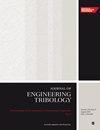钢基体上硬铬和磷酸锌转化涂层的干滑动磨损行为
IF 1.6
3区 工程技术
Q3 ENGINEERING, MECHANICAL
Proceedings of the Institution of Mechanical Engineers, Part J: Journal of Engineering Tribology
Pub Date : 2024-01-27
DOI:10.1177/13506501241227478
引用次数: 0
摘要
我们研究了转换涂层、AISI 430 不锈钢硬铬涂层和 AISI 1044 碳钢磷酸锌涂层的摩擦学特性。之所以选择这些基材,是因为它们在工业中的广泛应用。本研究的目标是通过涂层提高这些基材的耐磨性。我们进行了纳米压痕和球盘摩擦磨损试验,以研究基材和涂层的机械和摩擦学行为。我们发现,在 AISI 1044 钢上涂覆磷化锌涂层后,表面会形成一种新的相 Zn2Fe(PO4)2-4H2O(磷铁矿),从而提高了表面硬度。我们进一步发现,在本研究中应用的负载和速度条件下,AISI 430 钢上的硬铬涂层和 AISI 1044 钢上的锌磷酸盐涂层分别使摩擦系数降低了约 8%和 48%。我们将研究结果归因于以下因素的形成(1) 在铬钢接触的情况下,铬的附着层会导致试样和反面界面上的铬-铬接触;(2) 在磷酸盐-钢接触的情况下,由于磷酸盐磨损碎屑的压实和破碎,界面上会形成光泽层。磨损研究表明,铬涂层和磷酸盐锌涂层的磨损率分别降低了 80% 和 89%。我们注意到,在初始阶段,铬和磷化锌转化涂层的主要磨损模式分别是粘附和磨损。不过,对于硬铬涂层来说,粘附磨损在后期会转变为分层磨损。本文章由计算机程序翻译,如有差异,请以英文原文为准。
Dry sliding wear behavior of hard-chrome and zinc-phosphate conversion coatings on steel substrates
We have studied tribological properties of conversion coatings, hard chrome on AISI 430 stainless steel, and zinc phosphate on AISI 1044 carbon steel. These substrates were chosen due to their extensive industrial applications. The goal of the present study is to improve the wear resistance of these substrates through the coatings. We performed nano-indentation and ball-on-disc tribometer experiments to study mechanical and tribological behavior of substrates and coatings. We find that when zinc-phosphate coating is applied to AISI 1044 steel, a new phase Zn2Fe(PO4)2·4H2O (phosphophyllite) is formed on the surface that increases the surface hardness. We further find that coefficient of friction decreases approximately by 8% due to hard-chrome coating on AISI 430 steel and by 48% due to zinc-phosphate coating on AISI 1044 steel under load and speed conditions applied in the present study. We attribute our findings to formation of: (1) an adhering layer of chromium in the case of chrome–steel contact, leading to chrome–chrome contact at the interface of test-specimen and counter-surface, and (2) a glossy layer at interface in the case of phosphate-steel contact, owing to the compaction and crushing of phosphate wear debris. Our wear studies show maximum reductions in specific wear rate to be around 80% and 89% for chrome and zinc-phosphate coatings, respectively. We note that adhesion and abrasion are the primary modes of wear for chrome and zinc-phosphate conversion coatings, respectively at the initial stage. However, adhesive wear switches to delamination wear at a later stage for hard-chrome coating.
求助全文
通过发布文献求助,成功后即可免费获取论文全文。
去求助
来源期刊

CiteScore
4.20
自引率
5.00%
发文量
110
审稿时长
6.1 months
期刊介绍:
The Journal of Engineering Tribology publishes high-quality, peer-reviewed papers from academia and industry worldwide on the engineering science associated with tribology and its applications.
"I am proud to say that I have been part of the tribology research community for almost 20 years. That community has always seemed to me to be highly active, progressive, and closely knit. The conferences are well attended and are characterised by a warmth and friendliness that transcends national boundaries. I see Part J as being an important part of that community, giving us an outlet to publish and promote our scholarly activities. I very much look forward to my term of office as editor of your Journal. I hope you will continue to submit papers, help out with reviewing, and most importantly to read and talk about the work you will find there." Professor Rob Dwyer-Joyce, Sheffield University, UK
This journal is a member of the Committee on Publication Ethics (COPE).
 求助内容:
求助内容: 应助结果提醒方式:
应助结果提醒方式:


